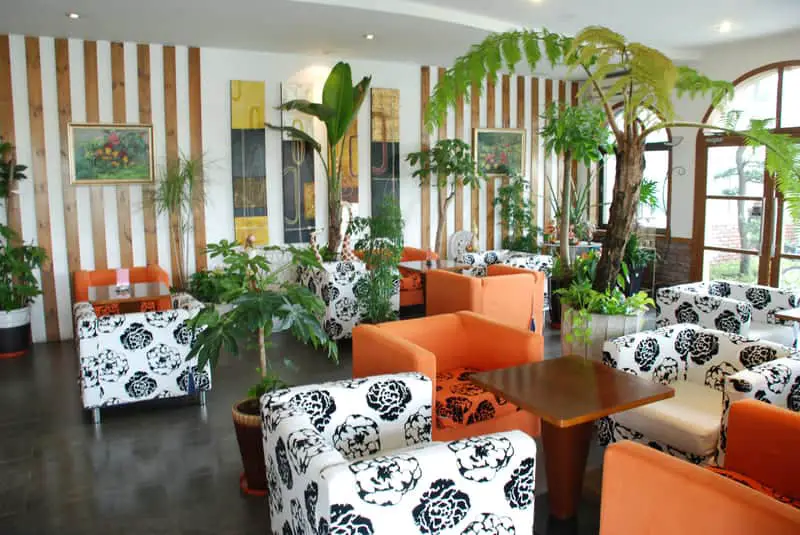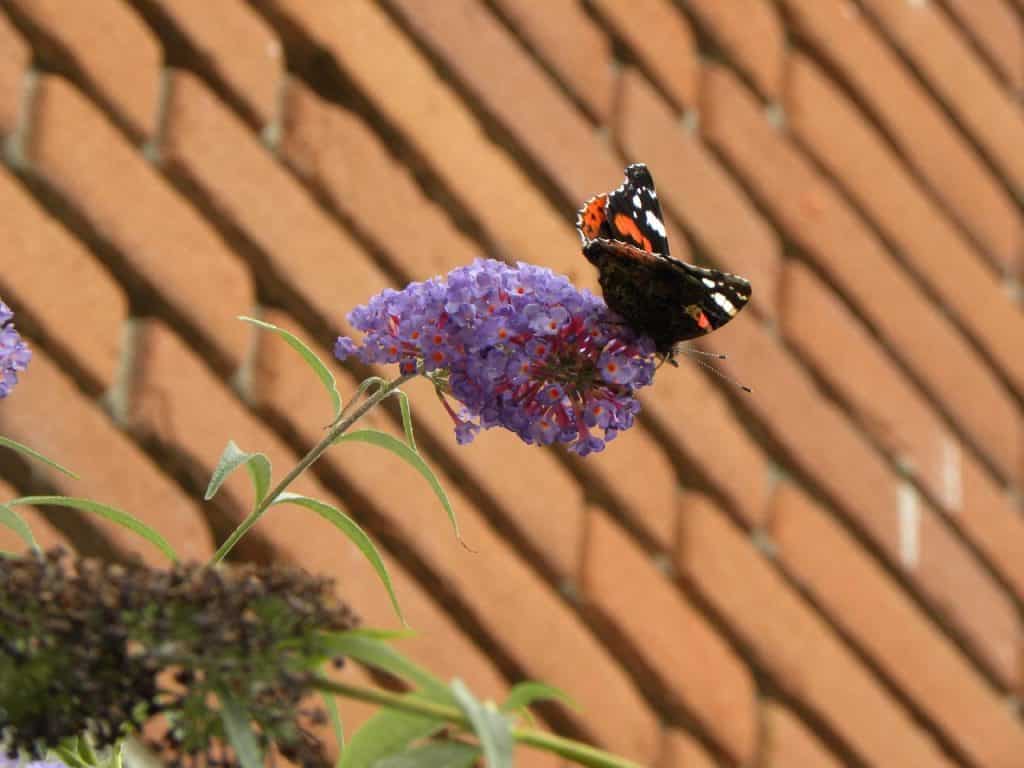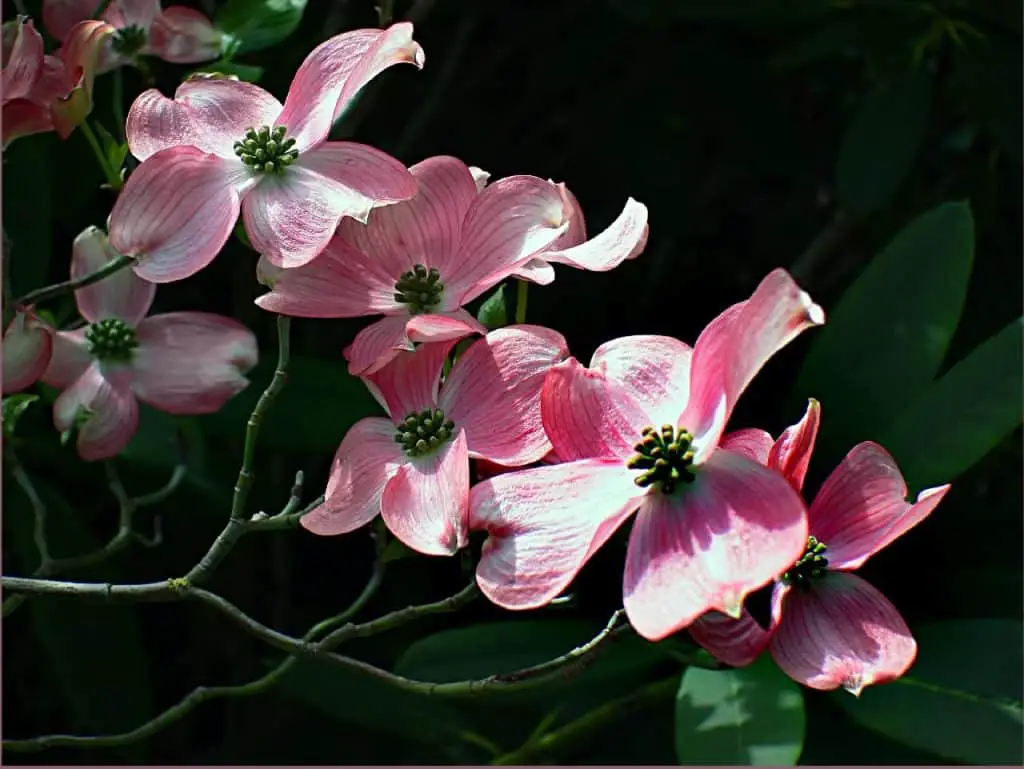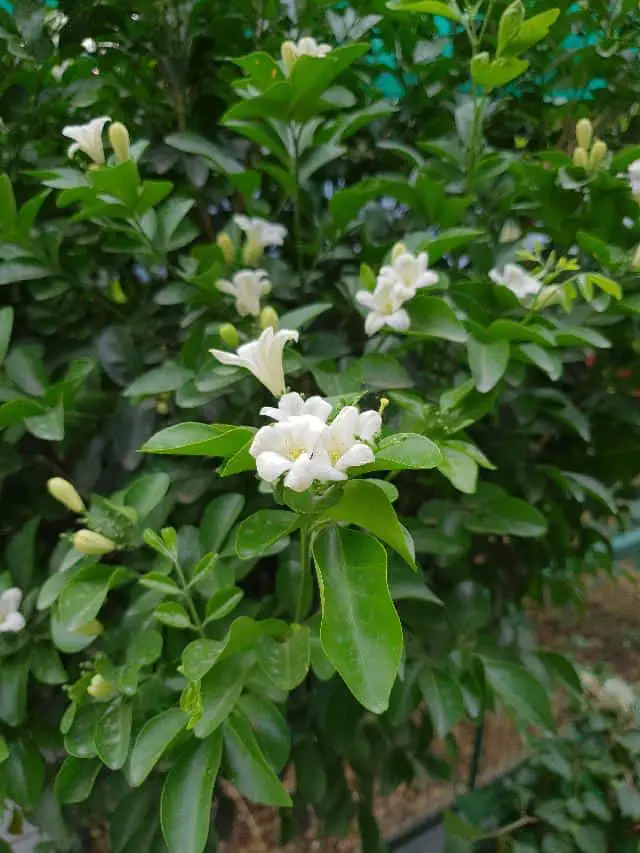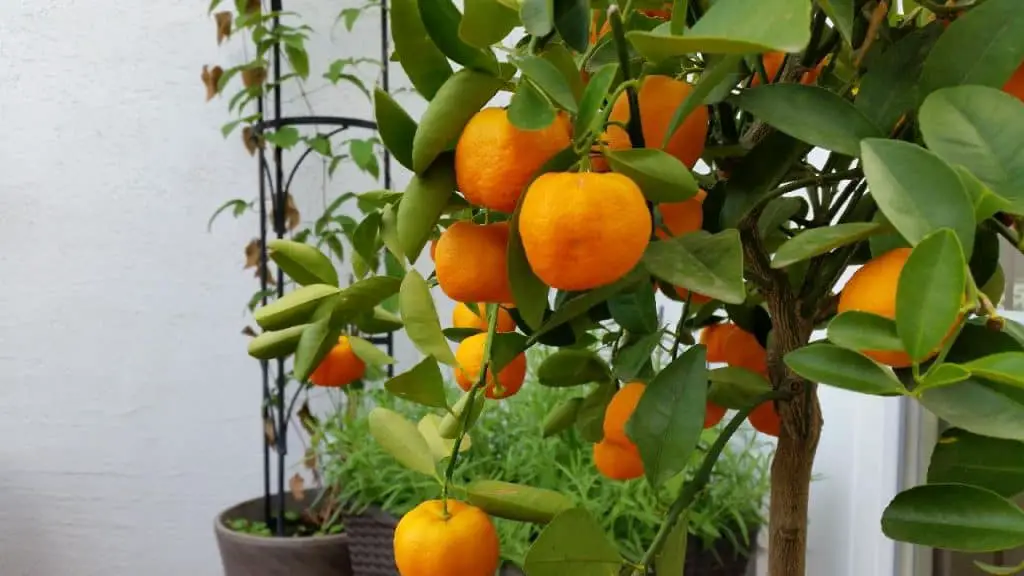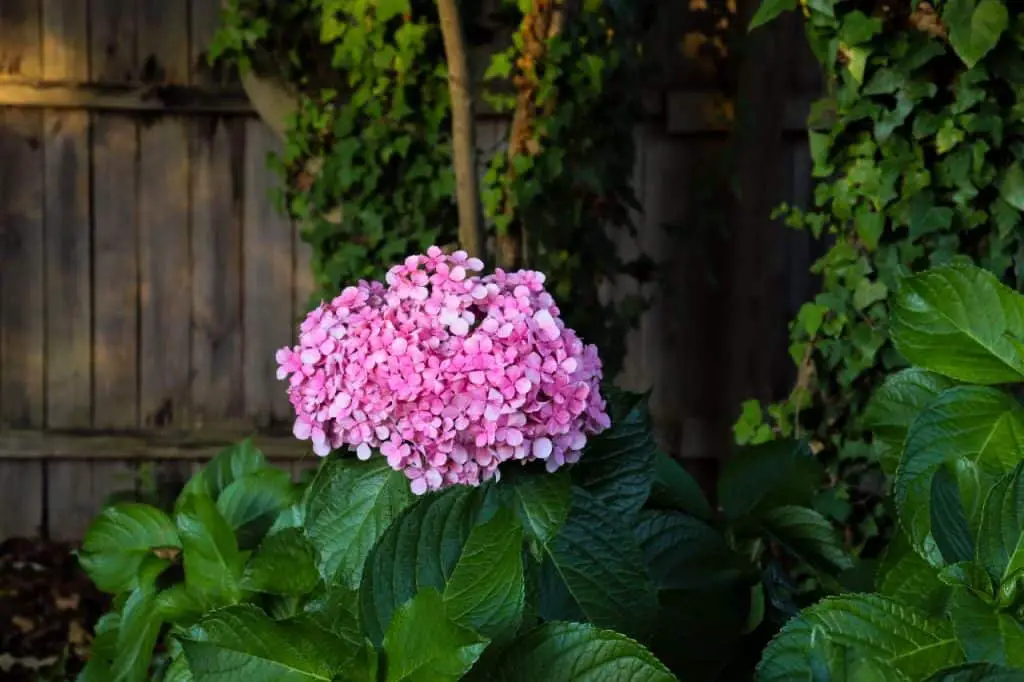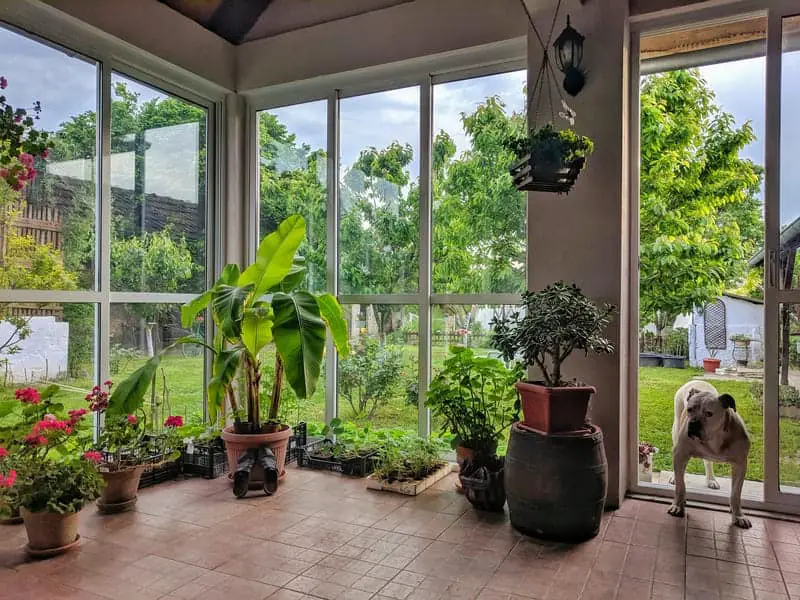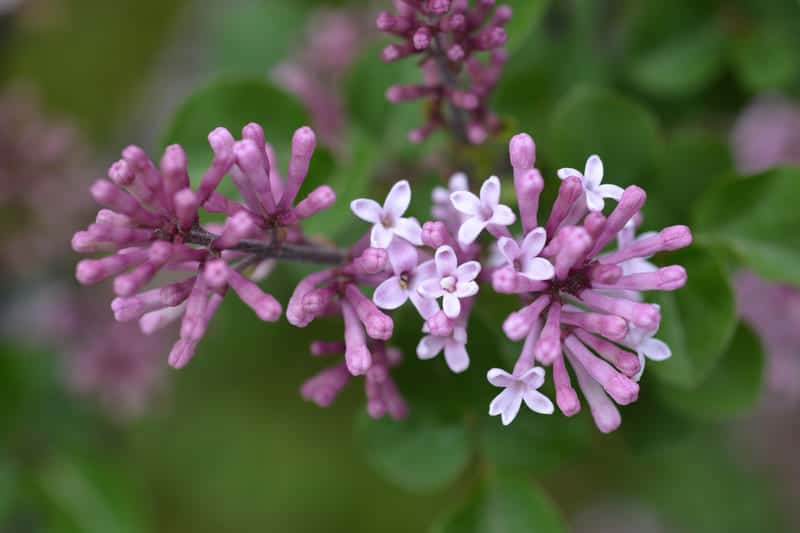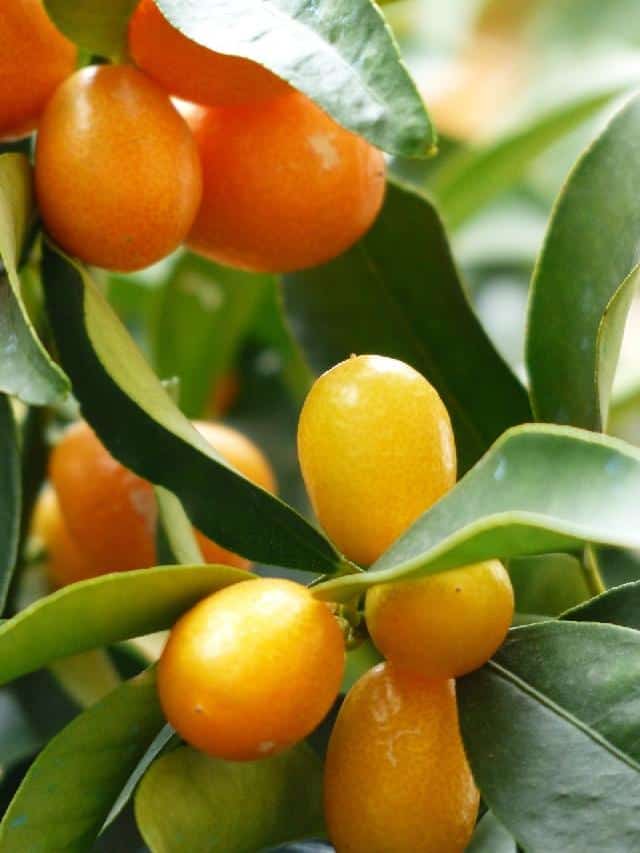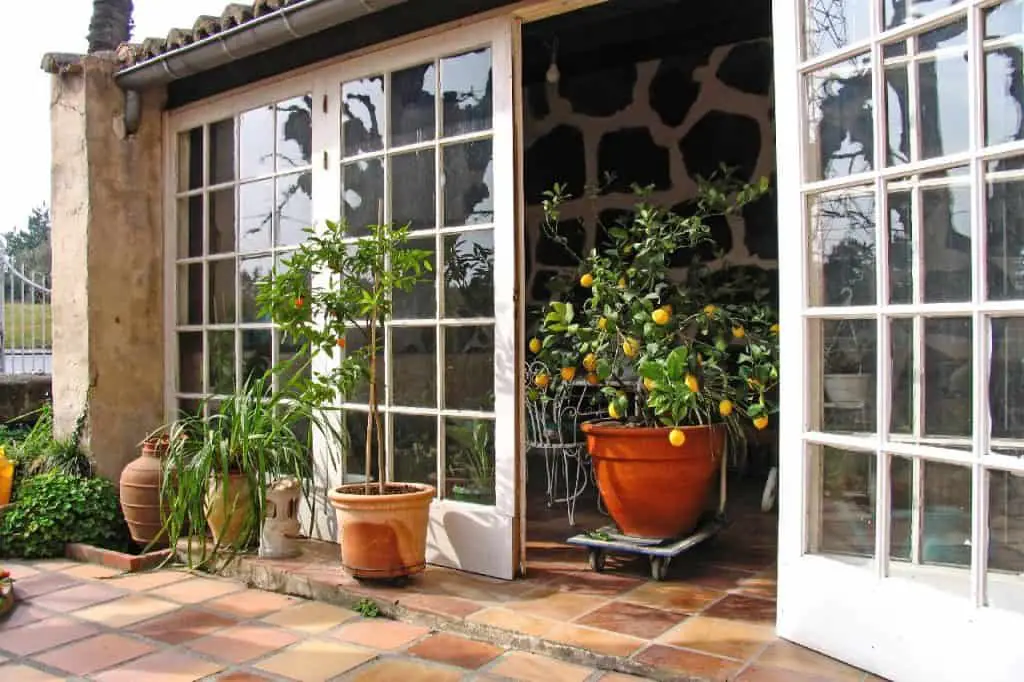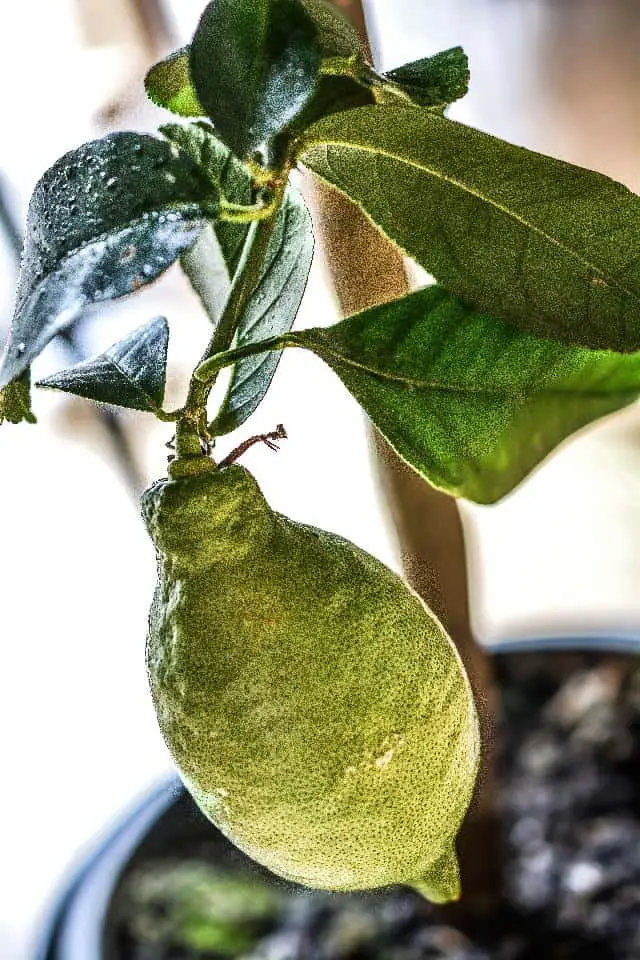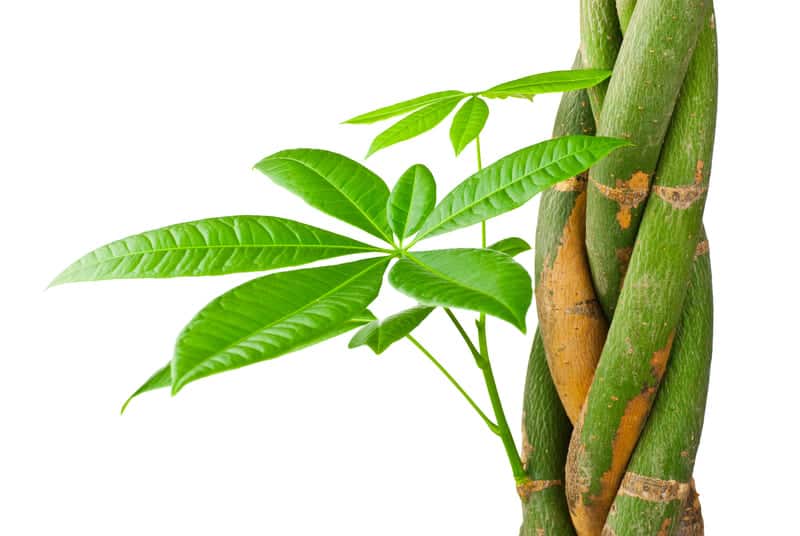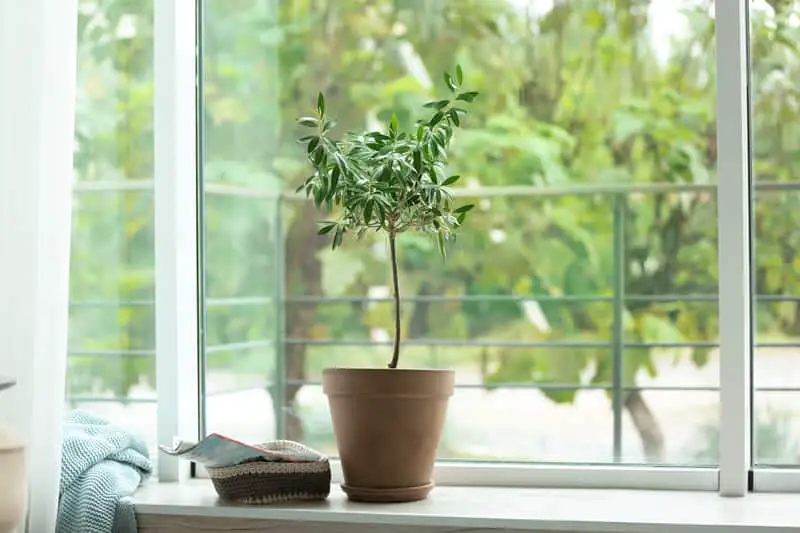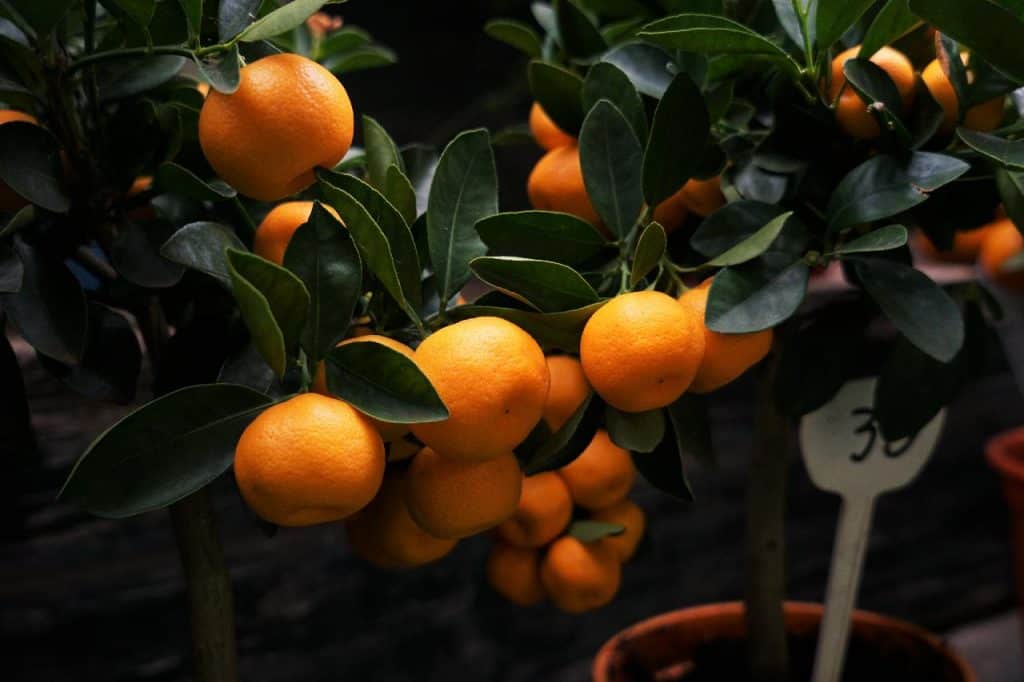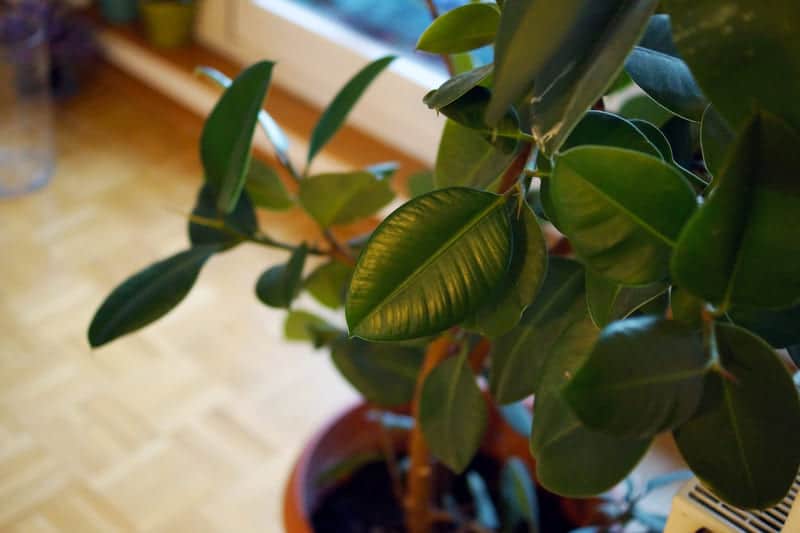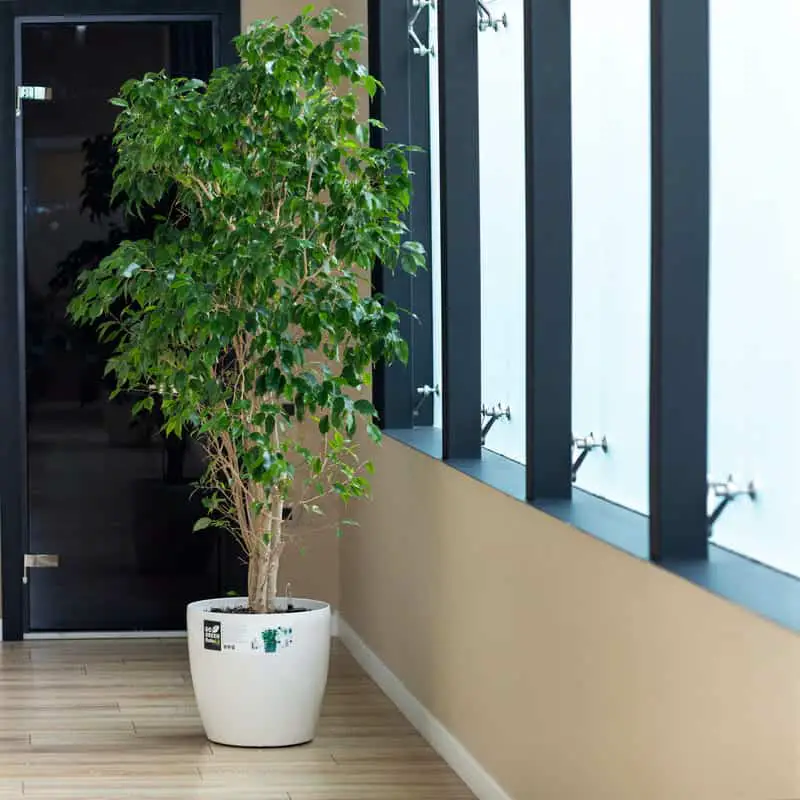Most readers will be thinking that trees are surely a plant that must grow outdoors? With your loving care and attention, the list below shows you 20 trees which grow surprisingly well in shade indoors.
It is fair to say that many will benefit from a trip out to the garden when the weather is warm and sunny, while some double may even provide you with fruit!
Best Low Light Indoor Trees
Continue reading for more details about how to enjoy some greenery indoors.
1. Areca Palm
This beautiful tree grows really well indoors and can grow to about 7 feet, if you provide indirect light and water it regularly.
It prefers shade so a location next to a window, maybe with a blind, will help it to grow well. As it is known to purify the air it will bring you cleaner air to enjoy too.
Also check: 25 Best Low-Light Indoor Hanging Plants
2. Butterfly Bush
Butterfly Bush (also known as Buddleia), as its name suggests, is the perfect plant to attract butterflies. Grown indoors, this may not happen so much but if the plant is moved outdoors on warmer days, you can enjoy visiting insects all summer long.
The flowers are a beautiful lilac in cone shape and bees, ladybugs and butterflies are attracted by the scent. This tree can grow up to 12 feet outside so try to choose a dwarf variety to allow its roots to spread widely.
This tree dislikes acid soils. Water it generously indoors when in flower and enjoy the visitors. If you place it close to an open window, you will get plenty!
3. Dappled Willow Tree
This tree is also known as the Flamingo Willow (the Hakuro-Nishiki variety of the Willow family). Think of the flamingo bird standing on one foot, as the tall, thin trunk of the tree and the foliage then delights the eye with green leaves, finishing magnificently in pink topped leaves.
In spring, this tree also produces catkins to delight the eye, which flutter gently in the breeze. It can grow to nearly 3 feet in height and do not worry if the leaves are absent in the dormant period.
They will reappear in spring each year, to delight you from catkins to lollipop tree shape. Enjoy! It is easy to care for this plant; it tolerates most soils but keep it watered and trim it regularly, when dormant in the winter. Try to give it some summer sunshine outside.
4. Dogwood
This tree is incorporated into outdoor gardens for its beautiful flowers but also the bright autumn color in its branches, which range from deep red to orange. It loves shade and if potted indoors, you can enjoy its color even when outdoor trees are losing their leaves.
Water it regularly particularly in hot weather, adding some compost with lots of humus to encourage healthy growth and to keep the soil slightly acidic to enjoy colorful branches next autumn. Pruning regularly will keep its growth in check indoors.
5. Gardenia Tree
This tree provides you with a delightful fragrance when the tree is in bloom. You need to keep removing wilted flowers, in order to keep it flowering. It grows to about 2 and a half feet, and it is one of those trees which does well both outdoors and indoors.
They like a bright position in summer but will grow well indoors next to a window with indirect light. If it is indoors in a pot, ensure the compost is suitable for an acidic-loving plant and water it weekly to keep it flowering.
Your gardenia tree may need more moisture in dry periods, so check the soil if in doubt. Mulch the roots of Gardenia with organic, well-rotted compost and this will help to conserve moisture. If you notice that flower buds are dropping, the cause is often lack of water so keep an eye on it and water as needed.
6. Grapefruit Tree
Planted from seed, it might take 5 years before this seed becomes a tree but with regular watering and feeding, this tree enjoys being indoors. For children, this is a miracle to behold if the seed grows! Children can enjoy the same trick seeding lemons and limes.
The foliage and trunk of the Grapefruit tree are very pleasing to the eye indoors and they can even be decorated as an alternative to a Christmas tree, by wrapping tinsel round it in winter months.
Grapefruit trees prefer well-draining, slightly acidic, loamy soil. Fertilize all citrus trees weekly when they are growing fruit. They love magnesium and iron; you can buy specialized citrus fertilizer including all the necessary nutrients for citrus to ensure it keeps in good health.
Citrus trees are not fond of drafts; they need a minimum temperature of about 65 degrees Fahrenheit overnight. The Grapefruit tree enjoys sunlight through blinds, if you have a warm spot in a conservatory and maybe an open door to allow in the summer sunshine.
7. Hydrangea Bush
When grown outdoors, this shrub adores shade and can grow up to 4 feet. Indoors, you can have some fun because the color of its flowers will change, according to the soil type in which it is placed.
If you would like blue blooms, ensure it is acidic (with a PH of 5.5 or lower) and if you prefer pink, then add more nitrogen as a fertilizer or humus-rich compost to the soil to achieve a higher PH soil level.
8. Japanese Banana Tree
This tree is a really elegant addition to your home which can survive well in a warm, area with indirect lighting. It can grow to a tall, 4 and a half foot plant, and as it is used to growing in shady, moist jungles in the wild, make sure you water it well particularly in warm, summer months.
When the topsoil feels parched, water it well. It has really enormous, wide, green leaves with fabulous, cream-colored flowers. It needs to be fertilized regularly and if placed in a warm spot, the light will encourage its flowers to turn into small bananas.
Be careful though that these are not edible, so ensure your children and pets do not eat them!
9. Korean Lilac Tree
This tree grows outdoors in Korea but it is well worth considering as an indoor tree for its double blooming habit. The flowers smell delightful in May and June and their purple-colored blooms will cheer your eyes and your nose.
Its smell is exquisite, so after the citrus blooms are finished, this one can take over. It has a second flush of flowers in late August, so your house will have its own delicious natural air freshener. It can grow up to 5 feet in a pot and slightly taller out in the garden.
10. Kumquat tree
Also known as Citrus japonica, this tree provides you with sweet-smelling flowers like all the citrus trees, and Kumquat fruit too. The Kumquat fruit is quite close to an orange in color and shape but in the potted tree variety, the fruit will probably be quite small.
This tree is native to Japan, India and China and can grow to 9 or 10 feet tall. In the wild they can grow even taller! The Kumquat Tree’s flowers will scent your rooms in spring but it will appreciate being outdoors in summer.
If possible, move it out for a few months to enjoy the sunnier weather. In order to produce fruit, it will need weekly feeding like all the other citrus plants mentioned. Allow your Kumquat lots of outdoor sunshine in summer and it will reward you in winter with those fabulous smelling blooms.
11. Lace Lady Tree
Also known as Robinia and Twisty Baby, this tree is a False Acacia, which can grow up to a height of 6 feet. It grows well both indoors and outdoors and prefers a sunny spot.
However, it does tolerate indoors partial shade and if you allow it some summer holidays outdoors, this tree’s unusual curly leaves will provide a delicate, leafy plant to enjoy in any location.
12. Lemon tree
If you are searching for a tree with fragrant flowers, then a Lemon tree gives you the most beautiful, scented white flowers that fill a whole room with their delicious smell. For fruit, it is best to start with a grafted plant, in a small pot, which will limit its size.
You can re-pot into larger space when it requires it. This tree needs really good drainage and although it prefers sunlight, it will thrive indoors in winter, providing you move the pot outdoors in summer.
Fertilize it weekly with magnesium and iron; you can buy specialized citrus fertilizer. Lemon trees are not fond of drafts; they need a minimum temperature of about 65 degrees Fahrenheit overnight.
13. Lime Tree
Lime Tree is another citrus tree with delicious smelling blooms. The care for the Lime is similar to the Lemon tree and it is worth growing this tree just for the scent of its flowers.
However, later in the year if you have provided this tree with the correct soil, light and water, your flowers will convert to delicious limes, for use in home cooking or adding to cocktails! See fertilizer they need in Tips below.
14. Money Tree
The twisted trunk of the Money Tree is seen as a lucky charm in some cultures in South America where it is a native. It is said to lock in good finance for the owner of the plant.
This tree adapts well to being indoors. It grows rapidly and can reach almost 10 feet so branches are usually pruned back in winter, to keep new growth fresh and plentiful.
Although it enjoys bright, indirect light it can grow really well in low light conditions such as an office space, with fluorescent lighting. Keep your Money Plant out of direct sunshine and water it regularly; it likes moist conditions but you also need to feed it at least monthly to ensure verdant foliage.
Also check: Brown Leaves On A Money Tree
15. Olive Tree
Olives are eaten all over the world and are known for growing in sunny, Mediterranean climates with precious little rain. I must disclose that this tree will probably not produce olives indoors.
However, it looks beautiful with dark green leaves and a sand-colored trunk and olive branches are offered in times of trouble, to bring peace. You can plant this indoors in a pot and it will grow according to the size and light available.
So a shady spot is likely to produce a smaller plant which will need lots of regular watering. Ensure the pot has excellent drainage – these plants do not like wet roots. Think of those dry, dusty olive groves!
16. Orange Tree
This is the last of my citrus trees and this one is often sown from seed by hopeful children. In fact, can be a good surprise when it grows. However, they rarely grow true to the parent so you may find a very tall, hungry citrus after several years.
This tree requires sun but it will tolerate an indoor pot in winter if you can place it outdoors in summer. Feed it like a lemon or grapefruit and water regularly, with fertilizer, if you want it to fruit.
17. St John’s Wort
St John’s Wort is a small tree, which loves damp soil and grows well in semi-shade.
Its beautiful five-petaled yellow flowers have been known to herbalists for centuries for its antibacterial properties, which may also help fight inflammation, and research by the NRS (The National Research Council; US) suggests possible medicinal properties for the flowers.
It grows outdoors up to 3 feet but will probably grow slightly taller indoors. Please note that the berries should not be eaten, as they are slightly toxic.
It grows well in sand or clay; compost can be enriched with these to keep St John’s Wort looking at its best. Don’t worry if the plant dies back in winter – this is its outdoor habit and it will revive when spring arrives and grow new shoots and flowers.
18. Rubber Plant
This tree can grow as tall as 10 feet indoors so if it gets too tall for your space, you can prune it with good secateurs. This is a tropical jungle tree so it loves moist soil, which drains well.
In terms of preferred light, it has adapted to being in the shade so prefers indirect light in your home or office. If there is a lot of sunlight available it will still do well.
The Rubber Plant is known to remove toxins (such as formaldehyde) from indoor air so you can breathe better.
19. Umbrella Plant
There are several types of Umbrella Tree including the dwarf “Gold Capella” which has dazzling green foliage with the odd dash of yellow. The leaf formation resembles an open umbrella, from which the plant gets its name.
It is found in the wild in China and Taiwan, where it grows rapidly but can be pruned to fit your available space. The tallest it grows is approximately 6 feet!
Although it prefers indirect sunlight it can tolerate low light so keep its soil damp but not waterlogged. Good drainage is essential. This tree is another air-purifying plant, which benefits the quality of your indoor air.
20. Weeping Fig
This tree is choosy about being moved about into different light conditions so choose its location carefully and let it remain there. It really does not like radiators or drafts and prefers a bright spot, away from direct sunshine.
Can you picture a spot like this in your home? Then place your Weeping Fig Tree there and whenever the soil is dry, and then water it. You can mist the leaves in summer to keep it at its best. Be warned that this tree can grow up to 8 and a half foot!
Tips for these low light trees
- All citrus trees will benefit from a fertilizer that contains boron, copper, magnesium, manganese, iron and zinc. This can usually be bought in your local gardening center or order from a specialist citrus grower.
- Some of these trees can be toxic to pets and humans. So be careful of the fruit of the Japanese Banana Tree, the berries of St John’s Wort and the leaves of the Weeping Fig.

